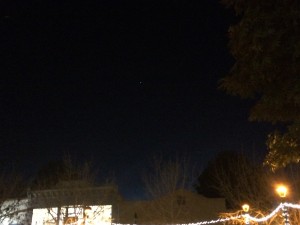Last week, I had a lovely visit to the Astronomy Dept at New Mexico State University in beautiful Las Cruces. I was invited to give one of the dept’s weekly colloquia about our research group’s work on very short-period exoplanets. While there, I talked dust devil science with my host Prof. Jim Murphy, his student Kathryn Steakley, and Lynn Neakrase.
I also enjoyed some excellent Mexican food at the Double Eagle Restaurant, which has been haunted by the ghosts of two young lovers since just after the Mexican-American War.
Just before dinner, the ISS also passed directly over our heads, and I got a very poor photo of it (left).
So, all in all, a great visit.
I’ve posted my abstract and presentation below.
—
On the Edge: Exoplanets with Orbital Periods Shorter Than a Peter Jackson Movie
From wispy gas giants to tiny rocky bodies, exoplanets with orbital periods of several days and less challenge theories of planet formation and evolution. Recent searches have found small rocky planets with orbits reaching almost down to their host stars’ surfaces, including an iron-rich Mars-sized body with an orbital period of only four hours. So close to their host stars that some of them are actively disintegrating, these objects’ origins remain unclear, and even formation models that allow significant migration have trouble accounting for their very short periods. Some are members of multi-planet system and may have been driven inward via secular excitation and tidal damping by their sibling planets. Others may be the fossil cores of former gas giants whose atmospheres were stripped by tides.
In this presentation, I’ll discuss the work of our Short-Period Planets Group (SuPerPiG), focused on finding and understanding this surprising new class of exoplanets. We are sifting data from the reincarnated Kepler Mission, K2, to search for additional short-period planets and have found several new candidates. We are also modeling the tidal decay and disruption of close-in gaseous planets to determine how we could identify their remnants, and preliminary results suggest the cores have a distinctive mass-period relationship that may be apparent in the observed population. Whatever their origins, short-period planets are particularly amenable to discovery and detailed follow-up by ongoing and future surveys, including the TESS mission.
